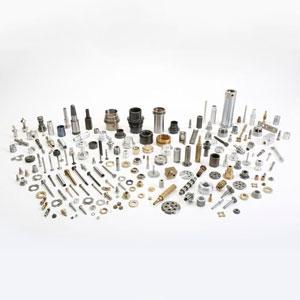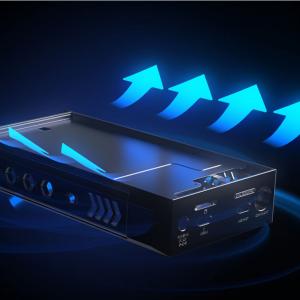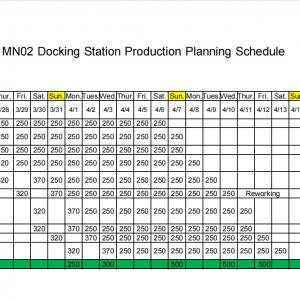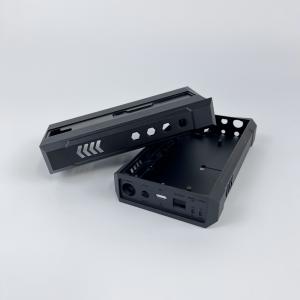2-axis CNC Machine
A 2-axis CNC machine is the most basic configuration and is typically used for simple operations such as milling or drilling. A CNC machine is designated 2-axis when it is capable of two directions of movement for the cutting tool — the X and Y axes.
3-axis CNC Machine
A 3-axis CNC machine is more versatile and can be used for a variety of operations, such as milling, drilling, and tapping. A CNC machine is designated 3-axis when it is capable of three directions of movement for the cutting tool — the X, Y, and Z axes.
4-axis CNC Machine
A 4-axis CNC machine is even more versatile and can be used for operations such as milling, drilling, tapping, and boring. A CNC machine is designated 4-axis when it is capable of three directions of movement for the cutting tool — the X, Y, and Z axes — and a rotational movement for the cutting tool around the X-axis, which is referred to as the A-axis.
5-axis CNC Machine
A 5-axis CNC machine is the most versatile and can be used for operations such as milling, drilling, tapping, boring, and turning. A CNC machine is designated 5-axis when it is capable of three directions of movement for the cutting tool — the X, Y, and Z axes — and rotational movement for the cutting tool around the X-axis and Y-axis, which are referred to as the A-axis, and B-axis, respectively.
How Are CNC Axes Defined?
- X-axis: left to right
- Y-axis: front to back
- Z-axis: up and down
- A-axis: 180° rotation around the X axis
- B-axis: 180° rotation around the Y axis
- C-axis: 180° rotation around the Z axis
What Is a Machining Center?
The term “machining center” refers to almost any CNC milling and drilling machine with an automatic tool changer and a table that secures or clamps the workpiece. It has the ability to move the cutting tool in multiple axes. This allows for more complex operations to be performed, such as milling, drilling, and tapping.
There are three main types of machining centers:
- Vertical Machining Center (VMC): A type of machining center that has its spindle oriented vertically.
- Horizontal Machining Center (HMC): A type of machining center that has its spindle oriented horizontally.
- Universal Machining Center (UMC): A type of machining center that has both horizontal and vertical spindles.
Advantages and Disadvantages of Using a CNC Machine
Advantages
The main advantage of using a CNC machine is the high degree of accuracy and repeatability that it offers. CNC machining is also much faster than traditional methods such as hand-cutting or milling, which makes it ideal for mass production.
Another advantage of CNC machining is that it allows for very complex designs to be produced, which would be impossible to create using traditional methods. Also, because CNC machines are computer-controlled, they can be easily programmed to produce multiple copies of the same design. Therefore, if you need to produce many identical parts, CNC machining is the ideal solution.
Disadvantages
One major downside of CNC machining is the initial cost of purchasing and setting up the machine. CNC machines are also complex devices that require specialized training to operate, which can add to the overall cost.
Another potential disadvantage is that parts produced using CNC machining may have less structural integrity than those made with traditional methods. This is due to the fact that CNC machines remove material from the part in order to create the desired shape, which can weaken the overall structure. However, this disadvantage can be mitigated by choosing the right materials and using proper design techniques.
Who Should Use a CNC Machine?
In general, CNC machines are well suited for anyone who needs to produce parts with a high degree of accuracy and repeatability. This includes manufacturers who produce large quantities of parts, as well as those who need to create prototypes or low-volume production runs. If you’re considering adding a CNC machine to your manufacturing operation, be sure to weigh the pros and cons carefully to decide if it’s the right choice for you.
Materials Used in CNC Machining
CNC machining can be used to machine parts from a wide range of materials, including:
- Metals (steel, aluminum, brass)
- Plastics (acrylic, polycarbonate)
- Composites (fiberglass, carbon fiber)
- Wood
In general, any material that can be machined using traditional methods can also be machined using CNC technology.
How to Choose the Right CNC Machine for Your Business
There are many factors to consider when choosing the right CNC machine for your business. The type of business you have, the products you produce, and the volume of production all play a role in determining which CNC machine is best suited for your needs.
1. Type of Business
The type of business you have will help to narrow down the options available to you. For example, if you run a small woodworking shop, a desktop CNC routing machine may be all you need. On the other hand, if you run a large manufacturing operation, you will likely need a more industrial-sized machine.
2. Products You Produce
The types of products you produce will also help to determine which CNC machine is right for your business. For example, if you produce small parts or products with intricate designs, a smaller machine may be better suited for your needs. On the other hand, if you produce large parts or products with simple designs, a larger machine may be more appropriate.
3. The Volume of Production
The volume of production will play a role in determining the size and capacity of the CNC machine you need. For example, if you produce a large volume of products, you will need a machine that is able to handle the increased production demand. On the other hand, if you produce a small volume of products, a smaller machine may be all you need.
CNC Machine Applications
CNC machines can be used to create a wide variety of parts and products. Their applications are limited only by the imagination of the designer. Some common examples of parts that can be machined using CNC technology include:
- Gears
- Bearings
- Shafts
- Spindles
- Pistons
- Cylinders
CNC machines can also be used to create more complex parts, such as:
- Molds
- Dies
- Fixtures
- Tooling
Tips for Using a CNC Machine Safely and Effectively
CNC machines are powerful tools that can help you to create parts and products more quickly and accurately. However, it’s important to use them safely and effectively in order to avoid accidents and injuries. Here are a few tips to help you do just that:
- Read the manual: Before using a CNC machine, be sure to read the manual and understand the proper use of the machine.
- Get training: If you’re not familiar with how to use a CNC machine, be sure to get training from a qualified instructor.
- Use the proper tools: When using a CNC machine, be sure to use the proper tools and accessories.
- Follow safety guidelines: When operating a CNC machine, be sure to follow all safety guidelines.
- Inspect your work: After machining a part, be sure to inspect it for accuracy and quality.
- Maintain your machine: Be sure to properly maintain your CNC machine to keep it in good working condition.
Final Thoughts
CNC machines are an essential part of the manufacturing process. They allow for the precise and efficient production of parts and products. With their wide range of capabilities, they are sure to play a significant role in the future of manufacturing.
Overall, CNC machining is a versatile and accurate manufacturing process that offers many benefits over traditional methods. When used correctly, it can result in parts that are stronger and more precise than those made with other methods. If you’re considering adding a CNC machine to your manufacturing operation, be sure to weigh the pros and cons carefully to decide if it’s the right choice for you.
There is no “one size fits all” solution when it comes to choosing the right CNC machine for your business. The type of business you have, the products you produce, and the volume of production all play a role in determining which machine is best suited for your needs.




